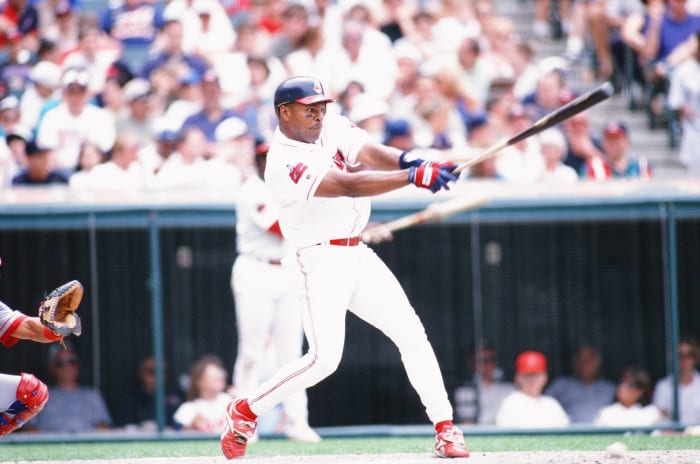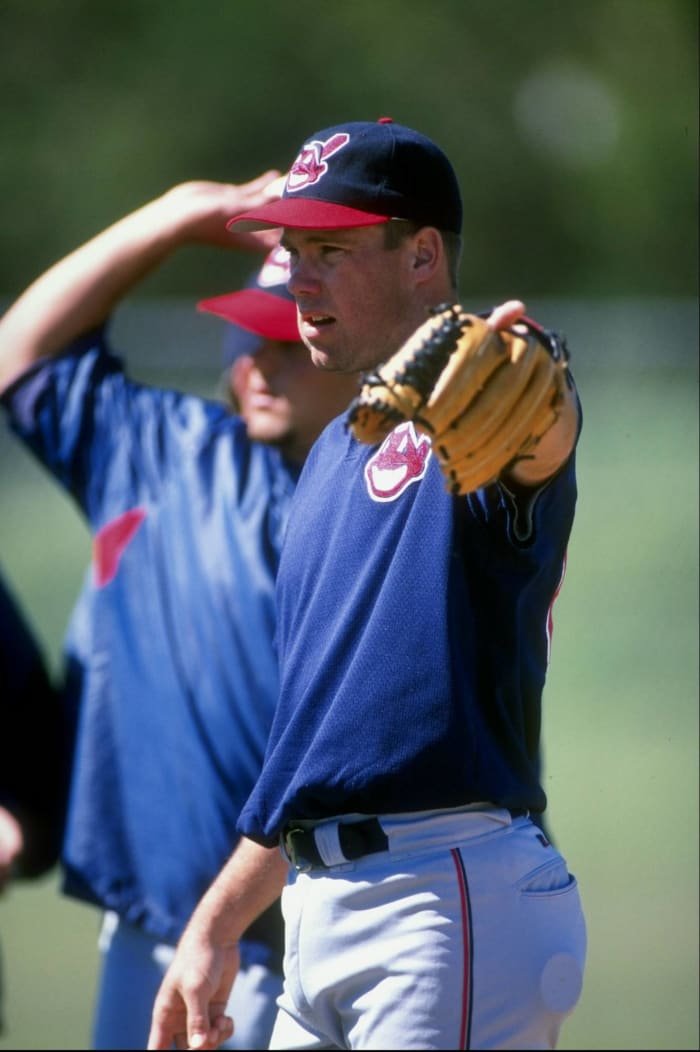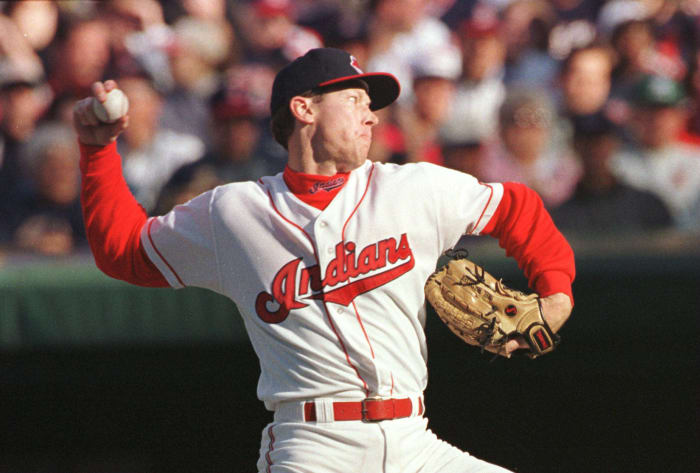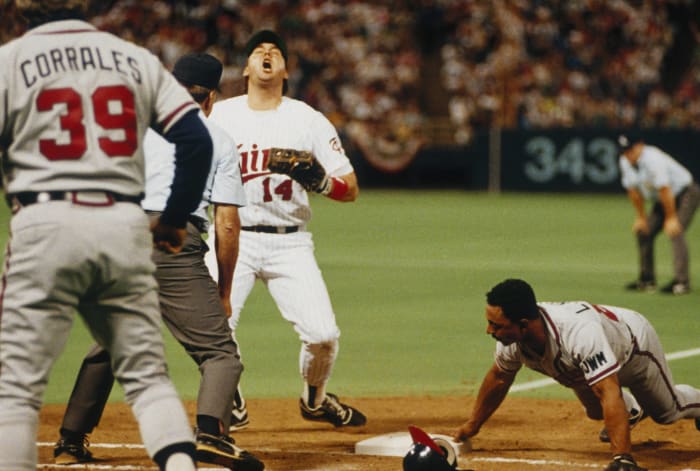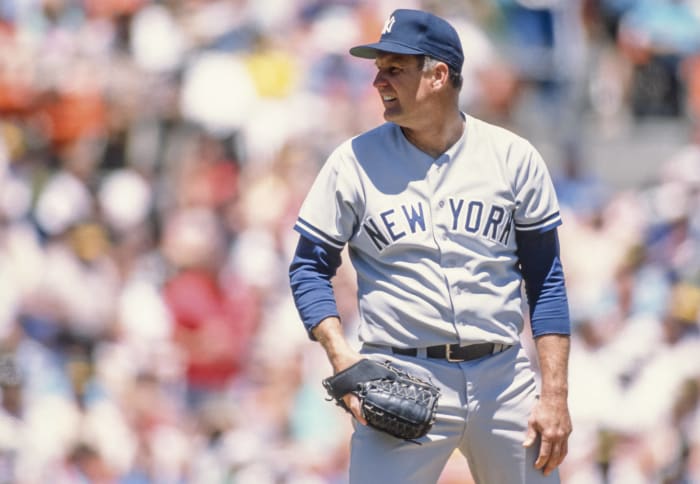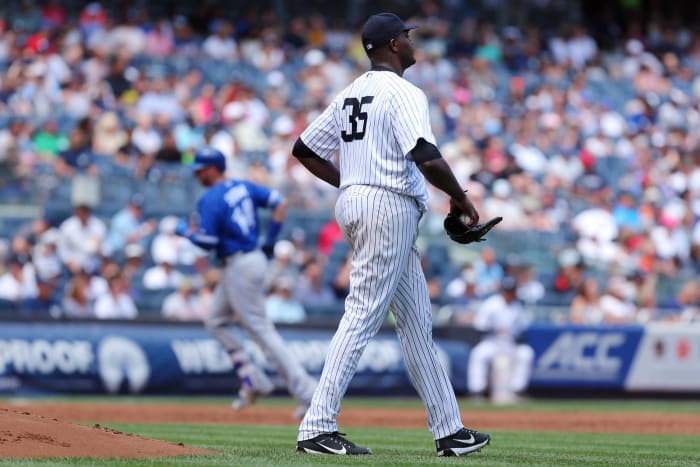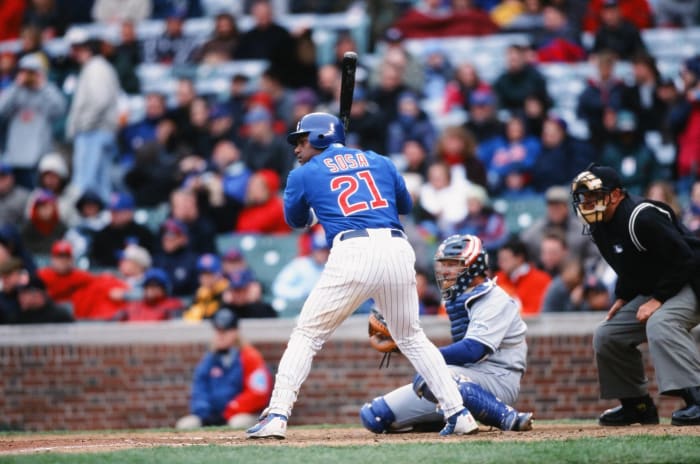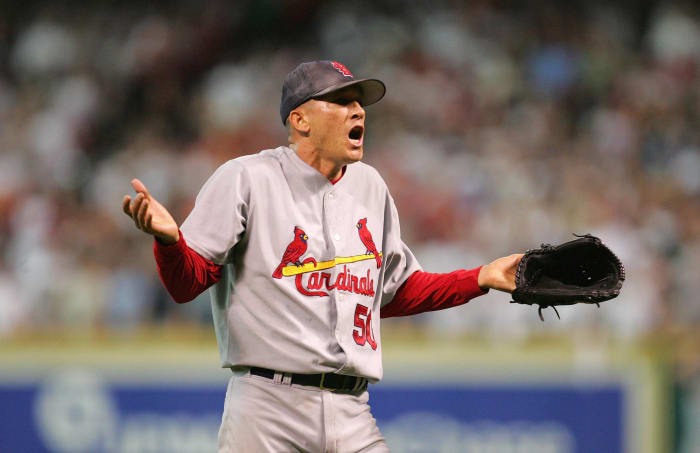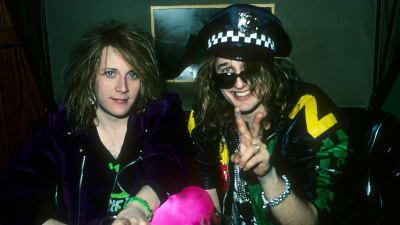When you think about cheating in Major League Baseball, you probably think about one word: steroids. While the list of players who used PEDs is extensive, with many of the names well-known, we're focusing instead on guys who cheated the old-fashioned way — by doctoring the baseball, corking a bat, using excess pine tar, stealing signs and doing just about anything else to get an edge.
Let's take a look at some of baseball's most notorious on-field cheaters and the incidents that earned them that distinction.
Sporting News via Getty Images
In his prime, Belle was one of baseball's most intimidating players, both physically and as a home run threat. At least in 1994, some of those blasts were ill-gotten. On July 15, 1994, the Indians were playing the White Sox, and Sox skipper Gene Lamont was tipped off that Belle's bat was corked. He challenged the bat, and after a few days — and plenty of shenanigans (more on those in a bit) — Belle's bat was X-rayed and found to be corked (as were all of his bats), and he was suspended for 10 games, though the suspension was later reduced to seven games.
Bettmann/Getty Images
Despite the fact that the majority of cheating in baseball seems to concern pitchers doctoring baseballs, no "cheating" incident is more famous than George Brett's. In fact, Brett's situation is so infamous it even has a name: the "Pine Tar Incident." On July 24, 1983, with his Royals trailing the Yankees 4-3 and two outs in the top of the ninth, Brett homered to give Kansas City a 5-4 lead. Yanks manager Billy Martin appealed the play, claiming Brett's bat had more than the permissible amount of pine tar on it. The umps agreed, calling Brett out and ending the game, and Brett went ballistic, charging out of the dugout and trying to attack the crew, creating one of the most iconic video clips in league history. The ruling was later overturned, however, and Kansas City ended up getting the win when the game was resumed.
Focus on Sport/Getty Images
What is "gunk," you ask? Well, in Whitey Ford's case, it was a mixture of baby oil, turpentine and resin that he used to doctor the baseball. Ford claimed he didn't cheat in some of his best seasons, rather only when he needed to to stay in the game. Actually that isn't true. Ford admitted to cheating "a little" in 1963 when he notched 24 wins. Not only did Ford use "gunk," he also used his belt buckle and even his wedding ring to scuff the baseball. I guess that means that Ford wasn't cheating in his marriage — rather he was literally cheating with his marriage.
Craig Melvin/Allsport/Getty Images
By far the most memorable part of the Albert Belle bat-corking scandal was the fact that the Indians tried to cover it up with a caper straight out of an action movie. After the bat was confiscated, pitcher Jason Grimsley crawled through the bowels of the stadium until he reached the umpires' room, at which point he swapped Belle's corked bat with one of Paul Sorrento's. He couldn't put one of Belle's other bats in there because they were all corked. While Grimsley's mission was initially successful, he left plenty of evidence, and under the threat of FBI involvement, Cleveland eventually turned over Belle's bat to the league.
Sporting News via Getty Images
It had to be tough being Wilton Guerrero. You're the big brother of Vladimir Guerrero, one of the greatest and most beloved hitters of his generation, and all you are is a light-hitting utility player. If this was a comic book, Wilton would probably have gone on to become some sort of supervillain. Being that it was baseball though, Wilton just decided to go ahead and cork his bat. In 1997, with his Dodgers taking on St. Louis, Guerrero shattered his bat. Refreshingly, he didn't try to play dumb, eschewing a trip down the basepaths to instead hurriedly scramble around collecting pieces of the bat. That set off alarm bells, and he was tossed from the game thereafter.
Otto Greule Jr./Getty Images
Even though bat-corking is a frequently discussed practice, with many insisting that it is commonplace, there is debate about whether or not it actually helps. Billy Hatcher would probably say that it does. Hatcher's 1987 season in Houston was the best of a mostly undistinguished but lengthy career. During that year, he broke his bat on an infield hit against the Cubs, who just so happened to be his former team. Chicago alerted the umps that the bat had a hollowed-out section filled with cork, and the umps then informed Hatcher that he was ejected from the game. Still, 1987 was the only year Hatcher cracked double digits in home runs, so in this case one can argue that cheating did in fact pay.
Doug Pensinger/ALLSPORT/Getty Images
You know you're a cheater when even your teammates don't back you after you're accused of underhanded tactics. Orioles manager Davey Johnson accused Hershiser of cheating after the hurler dominated his team for seven shutout innings. After the game, fellow Indians pitcher Chad Ogea spilled the beans, rationalizing Hershiser's cheating with classic fourth-grade logic: Since everyone else did it, why shouldn't Hershiser? Ogea went so far as to say that he was taught how to doctor the ball by Hershiser but was forbidden from doing so until he turned 35. Ah, what honor.
Focus on Sport/Getty Images
Most players who cheat have only their pride and reputations wounded. Rick Honeycutt dealt not only with that but also with an actual wound to boot. The thumbtack that Honeycutt taped to his finger to scuff the ball when he was with Seattle in 1980 ended up cutting him on the forehead, which was what caused him to get caught. To make matters worse, his attempt at chicanery didn't even work. On the two pitches he threw with the thumbtack involved, Honeycutt gave up two singles. So to recap, he tried to cheat, cut himself in the process and the batters still reached base. Oh, and he got suspended and fined for the incident. Sounds like a winning effort all around.
Focus on Sport/Getty Images
With so many pitchers populating this discussion, it's probably good to include a position player who cheated on the biggest stage the old-fashioned way: by using some know-how, some brute strength and some clever tricks to get a huge out call to go his way. In Game 2 of the 1991 World Series, Atlanta's Ron Gant smacked a single to left field. When the throw came to third, Gant briefly thought about going to second but hustled back to first in time to beat Kent Hrbek's tag. However, Hrbek decided to pull Gant off the bag, using some subtle leverage to try and make it appear that Gant's momentum took him off the base. Perhaps the only person in the United States who thought Hrbek's ruse worked was the first base umpire, but that was enough and Gant was called out. To this day, you can easily anger a Braves fan by bringing up this play.
David Madison/Getty Images
Tommy John has more claims to fame (or infamy, depending on your point of view) than just being the namesake and first recipient of arguably the most famous surgical procedure in sports history. He was also apparently an accomplished scuffer of the baseball and seen by many as an elegant cheater. John was never caught in the act, though Jim Frey, who managed the Royals while John was plying his trade with the Yankees, suggested that every ball John threw that ended up in Kansas City's dugout was beat up and covered in scratches, scuffs and other marks.
Matt Hazlett/Getty Images
One reason why so few pitchers are actually caught and punished for applying foreign substances to the baseball is because virtually all of them do it. It's common knowledge that doctoring a baseball can have a legitimate purpose, as it helps pitchers get a grip, especially during cold or humid weather. So if everyone, hitters and pitchers, knows that it's happening and no one is surprised by it, like they sometimes were in the days of Gaylord Perry and Don Sutton, should it be worthy of punishment? In Matusz's case, it was, as he was tossed with two outs in the 12th inning of a 2015 game between his Orioles and the Marlins. Matusz didn't seem too remorseful after the game, saying that he did what he did to get a better grip.
Rick Stewart/Getty Images
A recurring theme in this gallery of cheaters is the indignant bordering on absurd response most of them have, even when caught red-handed. Brian Moehler was no exception in this regard. In 1999 while pitching for Detroit against Tampa Bay, Moehler was investigated by the umpire, who found a piece of sandpaper taped to Moehler's thumb. Moehler, for his part, still maintained his innocence, which is pretty gutsy when getting caught in the act, insisting his fingers and thumb were merely dirty and that no funny business was going on. Sure, pal.
Focus on Sports via Getty Images
The story of Graig Nettles cheating is perhaps my favorite one for a variety of reasons. First, the material he used to try and enhance his bat wasn't tried-and-true cork but rather superballs. Nettles cracked a broken-bat single against the Tigers in 1974, and when the bat broke, superballs spilled out onto the field — which, if we're being honest, borders on laugh-out-loud funny. Nettles' excuse was even better, though, as he claimed that the bat was given to him by a Yankees fan who said it would bring him good luck and that he had inadvertently used it. Good luck? No, only embarrassment for the Yanks third baseman.
Bettmann/Getty Images
In a way, the act of cheating itself is kind of boring. If you're a pitcher, you're trying to scuff or otherwise alter a baseball so as to cause the airflow around it to change, thus making it change direction unexpectedly. It's a pretty basic concept, all things considered. What tends to make most of these cheating incidents fun is the way in which players shamelessly try to hide the evidence. While pitching for the Twins in 1987, Joe Niekro was caught off guard by a surprise inspection from the home plate umpire. When asked by the ump for the ball, Niekro threw it into the dirt. Strike one, as it were. Then Niekro tried to get nifty and demonstratively emptied out his pockets, in the process trying to fling away the emery board he was using to, you guessed it, doctor the baseball. It didn't work, and Niekro got tossed.
Focus on Sport/Getty Images
You'd think that the guy who titled his autobiography "Me and the Spitter" would have gotten caught for doctoring a baseball more than one time in a 22-year career, but you'd be wrong. Perry, who was always coy about what he was doing on the mound — which, to be clear, was frequently putting a foreign substance on the ball — was caught only one time, on Aug. 23, 1982, when umpire Dave Phillips (who was also involved in Albert Belle's corked bat game and George Brett's pine tar game) tossed him after he caught Perry holding an obviously doctored baseball. Perry received a 10-day suspension, but despite building a 314-win, Hall of Fame career at least partly, if not mostly, on an illegal pitch, no one seems to hold it against him.
Brad Penner/USA TODAY Sports
If at first you get caught cheating, cheat, cheat again. That was Yankees hurler Michael Pineda's strategy when he was pitching against the Red Sox in 2014. The first time around, Boston TV cameras caught what obviously was a foreign substance — pine tar — in Pineda's hand. You'd think Pineda would try to be more discreet, but you'd be wrong. Weeks later, the teams faced off again with Pineda on the hill, and this time the pine tar was on his neck, which probably made it even easier to see. Unsurprisingly, Pineda flew too close to the sun the second time around and got ejected and slapped with a 10-game suspension for his troubles. In a way, though, you've got to admire the sheer audacity involved.
Rob Tringali/Sportschrome/Getty Images
Kenny Rogers was 41 and having a great ride in the 2006 postseason, throwing 23 consecutive scoreless innings, including eight shutout frames against the Cardinals in Game 2 of the World Series. The only problem was that there was a visible smear of a naughty substance, believed to be some sort of pine tar mixture, on Rogers' hand. Not only that, but Rogers was also accused by some on St. Louis of scuffing the ball in other ways, with his accusers surmising that Rogers was using his fingernails to cut the balls. While the game generated big headlines at the time, it has mostly faded from memory, which is probably just how Rogers wants it.
Focus on Sport/Getty Images
Oh, you thought Pete Rose only bet on baseball? Think again. In 2010, Deadspin acquired one of Rose's bats used during the 1985 season, when he was chasing the all-time hits record. X-rays showed the bat to be filled with cork, which gave plenty of credence to long-whispered rumors that Rose doctored his bats. Given the rest of Rose's résumé, this kind of an accusation, even with what appears to be incontrovertible evidence, seems almost quaint by comparison. Charlie Hustle played the game hard, and apparently outside the lines, if need be.
Jonathan Daniel/Getty Images
The year was 1996, and Chris Sabo's career was nearing its end. He broke his bat on a foul grounder. The bat boy handed him a new one. He broke the bat again on another foul grounder but decided to keep using it. The bat shattered on the next pitch, and you guessed it: The umpires found cork in it and tossed Sabo from the game. There is at least the chance that the bat boy screwed this up and gave Sabo the wrong replacement bat, and there is also the chance that Sabo just had some corked bats among his collection and the bat boy happens to be a convenient scapegoat — you decide. Either way, Sabo's career ended a few games later.
Focus on Sport/Getty Images
There are many players who cheated but did not gain much, if any, of a tangible edge from their misdeeds. Then there is Mike Scott, whose career did an abrupt 180 right around the time he turned 30. Scott went from a flat-out mediocre pitcher to one who went on a five-year run of dominance, including a Cy Young Award in 1986. The guy who couldn't strike out batters in his 20s was suddenly setting them down with ease thanks to a filthy split-fingered fastball, one that Scott indirectly admitted was helped by some scuffs on the ball, though he stopped short of saying he was the one responsible for the scuffs. Had his Astros beaten the Mets in the NLCS that year, there might have been some vocal unhappiness given that some New York players griped about Scott's behavior even though they won the series.
Kevin C. Cox/Getty Images
I'll spare you the Will Smith puns and jokes other than to say that it's surprising that baseball's Will Smith was caught having a little too much fun doctoring the baseball in Atlanta and not Miami. In any event, Smith's arm had plenty of shiny stuff on it, and after a fairly brief investigation, the umpires saw fit to toss him from the game. Smith was unhappy and spent his walk of shame barking at Atlanta's dugout, which seems strange, until you consider that an overwhelming majority of pitchers apparently doctor the ball. Smith was probably just mad for being singled out.
Sporting News via Getty Images
Quick: Think of the most convincing lie you ever came up with to get yourself out of trouble. I bet it was better than what Slammin' Sammy concocted to try and explain away an obviously corked bat that umpires discovered in 2003 after Sosa broke his lumber on an RBI groundout. When the home plate umpire picked up a piece of the bat, he immediately saw cork, and Sosa's explanation that the bat was used only for putting on batting practice shows and that he grabbed it by mistake did not hold water. The slugger was ejected from the game and suspended. His attempt at an explanation wasn't good, but it was hardly the first time a player tried to fib his way out of trouble.
Focus on Sport/Getty Images
Sutton, like Gaylord Perry, was accused of plenty of shenanigans on the mound. If it could be done to a baseball to alter it, Sutton, it seems, tried it. He must have been pretty good at it, as well as pitching in general, because he, like Perry, also is a 300-game winner. I don't want to say that cheating pays — cheaters frequently win and winners frequently cheat — because there might be children reading this. But, well, just judge the results for yourself.
Ronald Martinez/Getty Images
If you're a cheater, what team is probably the worst one to cheat against? Did you say "your former team?" If so, you are correct. Julian Tavarez found this out the hard way when the Pirates alerted the umpires to the fact that Tavarez's hat was completely filthy. Umpire Joe West came out and tossed Tavarez, who was unhappy, but he at least tried to make the best of the situation, suggesting that he and home plate ump Ron Kulpa get beers after the game. Perhaps Tavarez shouldn't have complained. According to West, St. Louis' manager Tony La Russa more or less admitted that his reliever's hat was covered in pine tar.
Bettmann/Getty Images
Stealing signs, like doctoring the baseball, is common practice in Major League Baseball and goes back generations. Depending on whom you ask, this is either bad sportsmanship and actual cheating, perfectly acceptable within the bounds of competition, or actually a black mark on the team whose signs are being stolen, because the participants aren't doing enough to prevent it. In the case of Bobby Thomson's 1951 Giants, they reportedly employed an elaborate system of stealing signs to know what pitch was coming next. There is no definitive proof that Thomson knew Ralph Branca was going to throw him a fastball that would become "The Shot Heard 'Round the World," but there are many who say that Thomson did know — or that if he didn't, other players on the Giants did.
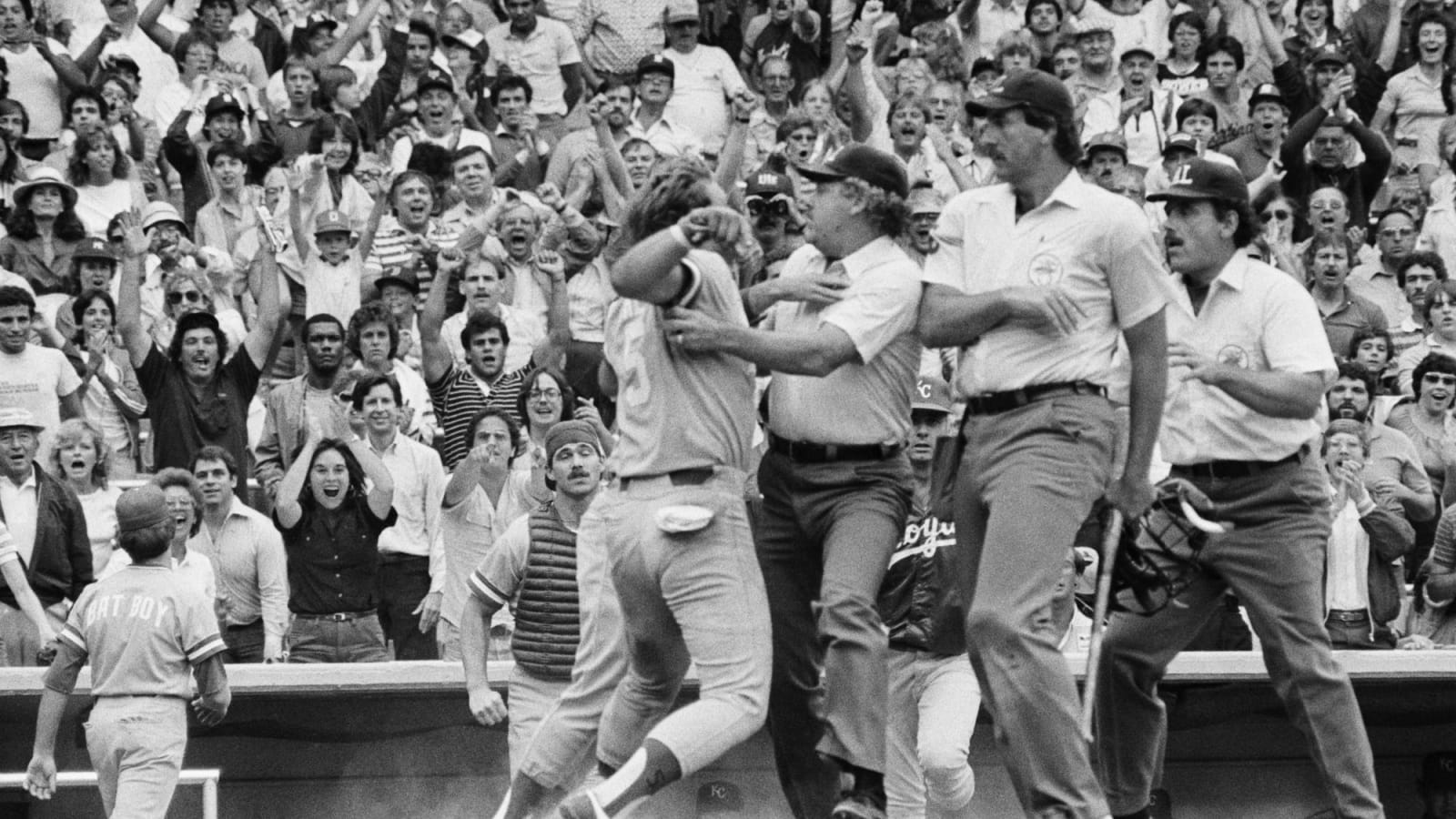
 +
+
